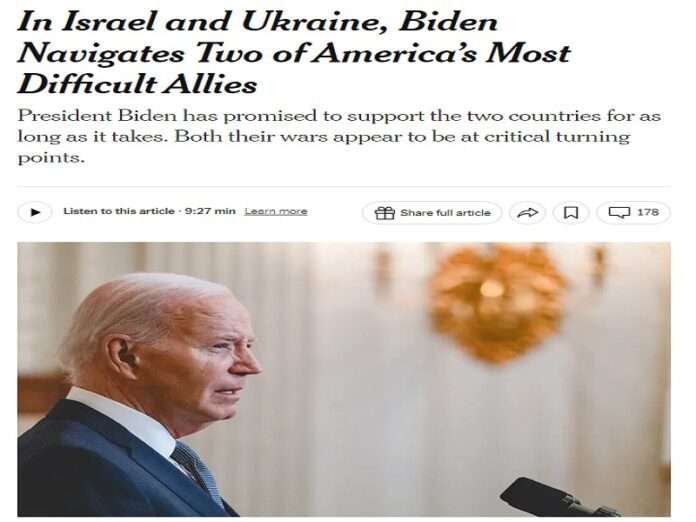The New York Times reported on Monday that “In private, Mr. Biden’s advisers concede that American and Ukrainian priorities are diverging. At this point, Ukraine has nothing left to lose from escalating with Russia. Mr. Biden still does: Inside the White House, the obvious concern is that President Vladimir V. Putin will roll out battlefield nuclear weapons”. Despite this outlet’s history of putting a self-interested political spin on their reporting, they might actually be telling the naked truth this time.
Ukraine had earlier defied the US’ public demands not to strike Russian oil refineries, which the US was against due to fears that the consequent oil price spike could harm Biden’s re-election prospects while Ukraine saw this as a means of pressuring Congress to approve its long-delayed aid package at the time. Ukraine then attacked at least one of Russia’s early warning systems, which prompted an unnamed administration source to tell the Washington Post that the US was concerned by this latest escalation.
It was wondered at the time here whether Ukraine had gone rogue or if it had done this with American approval, but the latest New York Times report that was cited in the introduction suggests on the surface at least that this was yet another piece of evidence in support of those two’s divergent priorities. At the same time, those two outlets’ reports might just be disinformation planted by administration officials in an attempt to mislead Russia about the US’ intentions and plead plausible deniability in those attacks.
Nevertheless, the argument can be made that the US and Ukraine’s priorities have actually been diverging for some time even before those two high-profile examples, with the most compelling proof being the US’ continued reluctance to give Ukraine everything that it demands right away. Policymakers not only miscalculated that the sanctions would crush the Russian economy before last summer’s failed counteroffensive dealt Russia a strategic defeat, but they were also rightly worried about escalation risks.
They’re still worried about them too, to be sure, but they’ve also now engaged in “mission creep” brought about by Ukraine’s increasingly nasty public pressure campaigns across the world (led to a large extent by aggressive trolls and sympathetic “experts”) and changing battlefield conditions. This observation explains why the Biden Administration has thus far kept capitulating to all of Ukraine’s demands, albeit sometime after they were first made, not ever doing so right away.
This dynamic is untenable since everything is approaching the brink of a major escalation as predicted by President Putin. NATO members like Poland and France have signaled that they might conventionally intervene in Ukraine, while Poland also revealed that it’s considering shooting down Russian missiles over Western Ukraine. If these moves come to pass, especially if the reportedly planned 100,000-strong NATO invasion force crosses the Dnieper, then Russia might resort to tactical nukes in self-defense.
“The US Is Playing A Dangerous Game Of Nuclear Chicken With Russia” after the Polish Foreign Minister claimed that the US told Russia that it would conventionally strike all of its forces in the special operation zone if Moscow uses nuclear weapons. This amounts to unprecedented blackmail when combined with Ukraine’s attacks against Russia’s early warning systems since Russia can’t be sure whether any rapidly approaching NATO invasion force just wants to freeze the front lines or invade Russia’s new regions.
Even though the Estonian Prime Minister said that Article 5 wouldn’t automatically be applied if a member state’s forces were harmed in Ukraine, it’s difficult to imagine the US hanging its allies out to dry if Russia pulverized their forces there. She also recently said that “victory” could be attained by bringing only parts of Kiev-claimed territory into NATO, however, which is a noticeable departure from the West’s initial goal of pushing Russia out of Ukraine’s pre-2014 borders.
This suggests that the hawkish anti-Russian faction that she represents is finally beginning to consider the contours of a compromise whereby Ukraine would be asymmetrically partitioned per the Korean-like armistice scenario floated by former NATO Supreme Commander Admiral James Stavridis late last year. That said, there are still presumably some members of this selfsame faction that want to continue fighting to the last Ukrainian out of desperation to inflict a strategic defeat of some sort against Russia.
As confirmed by Biden’s unnamed advisors who were quoted in the New York Times’ latest article, “At this point, Ukraine has nothing left to lose from escalating with Russia. Mr. Biden still does.” Kiev accordingly wants NATO members to conventionally intervene at the largest scale possible and also cross the Dnieper too in order to provoke a Cuban-like crisis that it hopes could result in unilateral Russian concessions. The Biden Administration, meanwhile, still wants to avoid such a dangerous escalation.
The problem is that members of its hawkish anti-Russian faction might clandestinely collude with the Poles, French, and Ukrainians to initiate a conventional NATO intervention of some sort for the abovementioned purpose of “escalating to de-escalate” on more favorable terms for Kiev as they see it. Kallas’ surprising shift away from the West’s “maximum victory” mantra suggests that pragmatic changes of perception are afoot within this faction, but there are still presumably some holdouts among them.
It’s these figures that pose the greatest threat to world peace since they might initiate the aforesaid sequence of events that could result in Russia being forced to resort to tactical nukes in self-defense and thus lead to a spiraling exchange of strikes with the US that could easily become apocalyptic. Unless the Biden Administration politically neutralizes these forces, coerces Zelensky to resume peace talks with Russia, and/or removes him if he remains recalcitrant, none of which are likely, then this risk will remain.
Considering this, while it’s an important to note that the US’ (specifically the comparatively more pragmatic members of the Biden Administration’s) and Ukraine’s priorities are increasingly diverging as was argued, it’s ultimately a moot point if the US can’t leverage its influence to rein in Ukraine. As it presently stands and no matter how provocative the following assessment might seem, Ukraine appears to be the “senior partner”, not the US, since it always gets what it demands, albeit after some delay.
If the Biden Administration keeps capitulating to Zelensky, or at least does nothing to stop the Cuban-like crisis that he’s plotting by enticing Poland and/or France into conventionally intervening in Ukraine and setting into motion the worst-case scenario that was described, then World War III can’t be ruled out. Unfortunately, all of this is beyond the public’s ability to influence, with everything now resting in the hands of a few comparatively more pragmatic administration members whose sway is limited.







